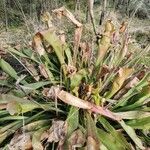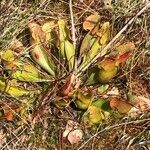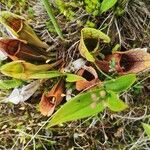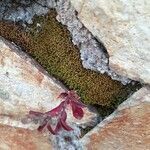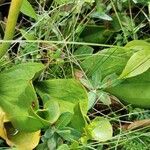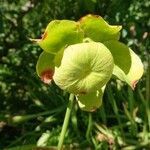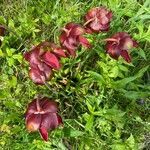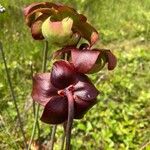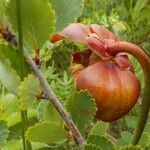Plants forming dense clumps; rhizomes 0.3-1.5 cm diam. Pitchers persistent, appearing with or after flowers and continuously all summer, decumbent or sprawling to ascending, nearly green with various degrees of red or purple veins, or suffused reddish or purplish to nearly uniformly purplish red, without white areolae, urceolate (gently S-curved like a hunter’s horn), 5-25(-45) cm (bulging distal of middle, 3-6 cm at widest point), firm, sometimes shiny or waxy, external surface glabrous or glabrate to densely pubescent, wings 1-3(-4) cm diam.; orifice round to oval, (gaping, with rainwater held in pitcher), 1.4-3.6 cm wide, rim green to purplish red, (thick, flaring), loosely revolute, scarcely or not indented distal to wing, (0.7-3.1 mm wide at thickest point); hood erect or with lobes arched together over orifice, same colors and veined as pitcher, reniform, undulate or entire, 2-5 × 3-7 cm, wider than long, basal lobes cordate, attached to sides of rim of orifice with no neck, distal portion somewhat abaxially recurved and notched apically, apex not apiculate, adaxial surface with decurved setae 0.6-1.8(-3) mm. Phyllodia absent. Scapes 22-79 cm, much longer than pitchers; bracts 0.5-0.8 cm. Flowers moderately fragrant to mixed fragrant and ill-scented; sepals purplish red, 2.2-4.2 × 1.5-3.5 cm; petals red to maroon, distal portion elliptic to obovate, 3.3-5.3 × 1.5-3 cm, margins entire; style disc green, 4-5 cm diam., (style arms 1.7-3.8 cm). Capsules 1-2 cm diam. Seeds 1.7-2 mm. 2n = 26.
More
Lvs 1–2 dm, obovoid, the wing semi-elliptic to semi-oblanceolate, usually 1–5 cm wide, the hood sessile by a very broad base; scapes 3–5 dm; fls 5–7 cm wide, the pet dark red-purple or rarely yellowish; 2n=26. Sphagnum-bogs, sandy or marly shores, and other wet places; Lab. and Nf. to n. Fla. and s. La., restricted to the coastal states southward, but far inland n. of the glacial boundary, to Man., Minn., n. Ill., Ind., and O. May–Aug. Two rather weak geographic vars.: var. purpurea, northern, s. to Md., Del., and N.J., with pitchers more than 3 times as long as wide, usually glabrous outside, the pet deep maroon to occasionally red; and var. venosa (Raf.) Fernald, southern, n. to Md., Del. and N.J., with pitchers less than 3 times as long as wide, usually bristly outside, the pet mostly bright red to pink. (S. venosa)
Can be grown by divisions or seedlings. Seeds needs stratification.

